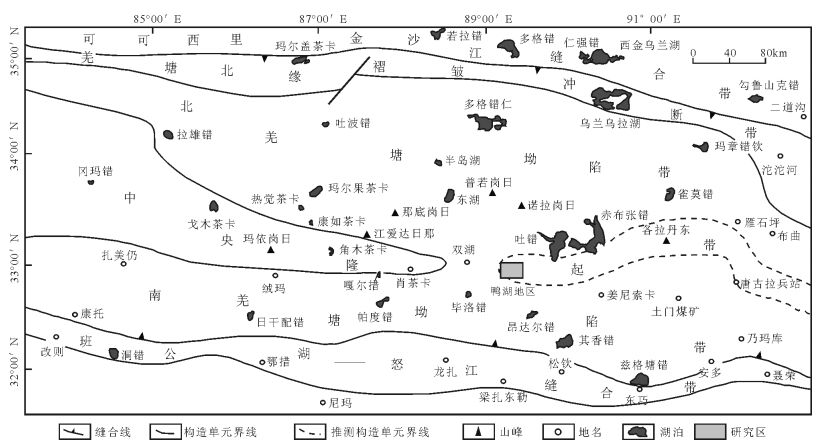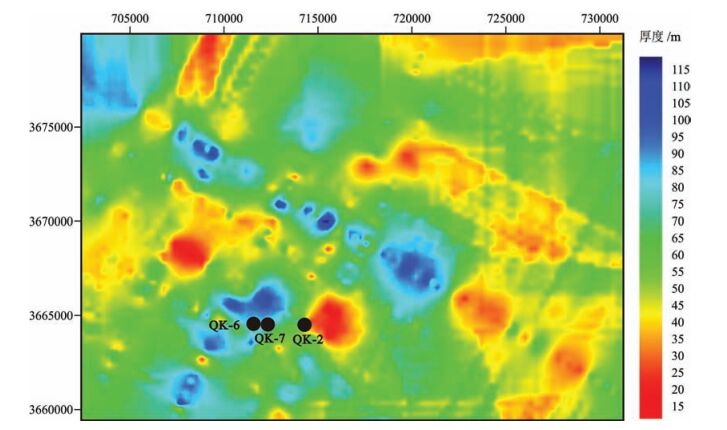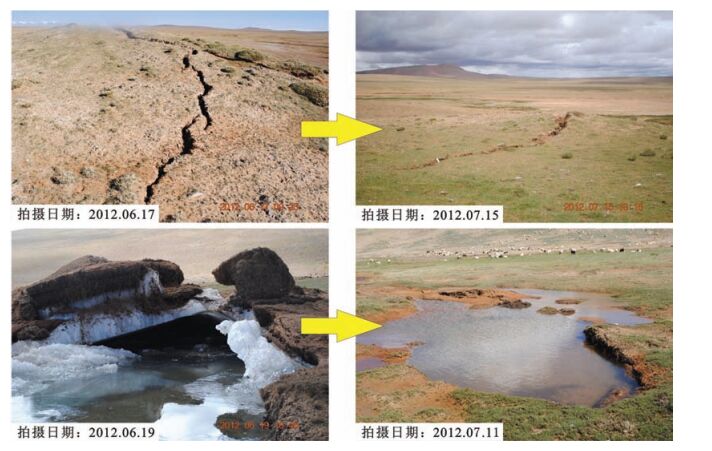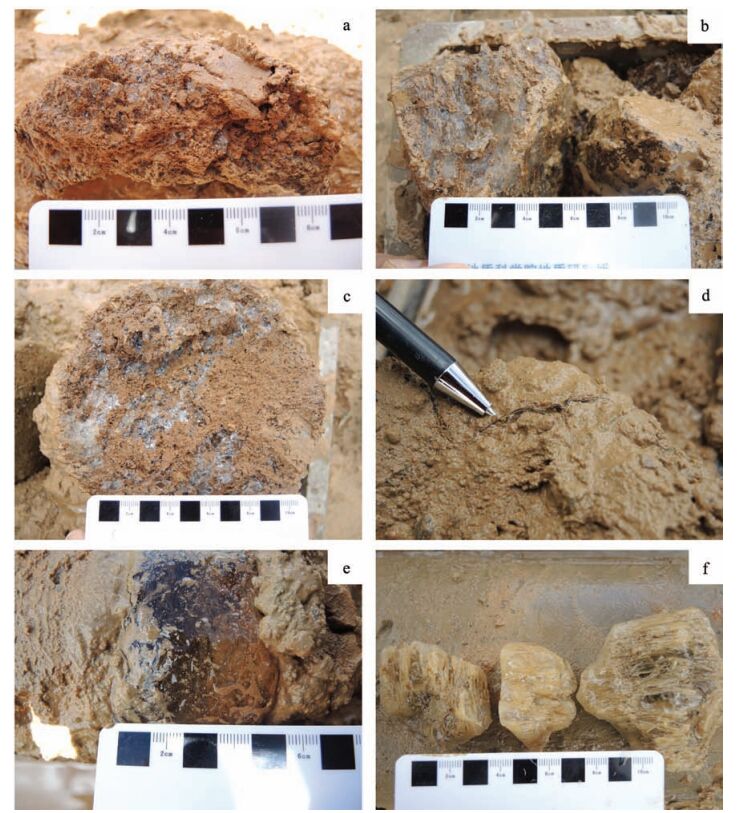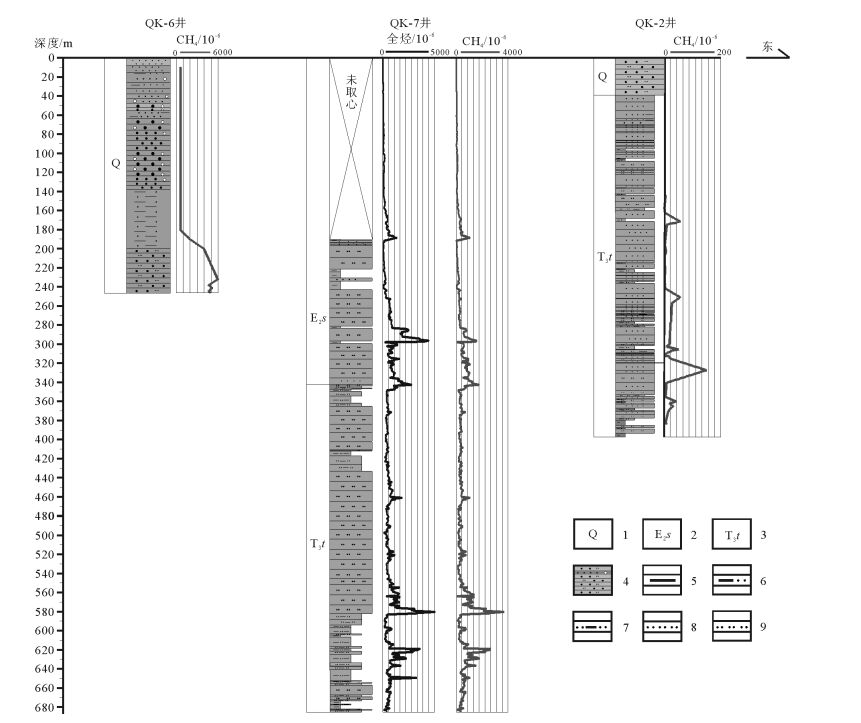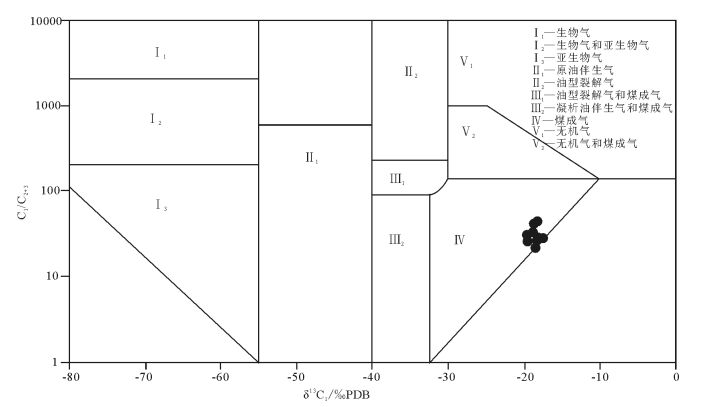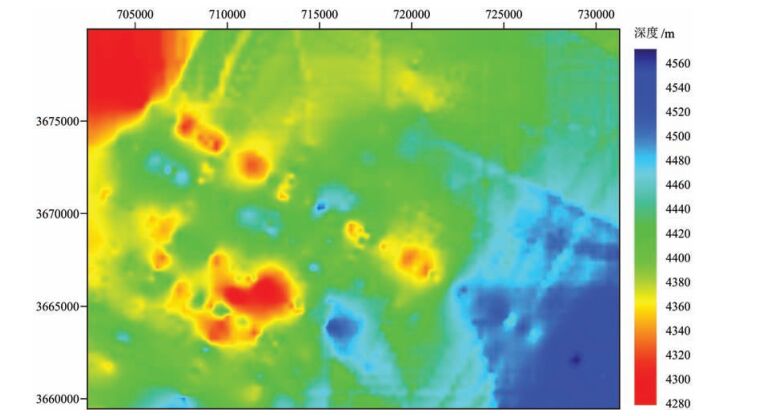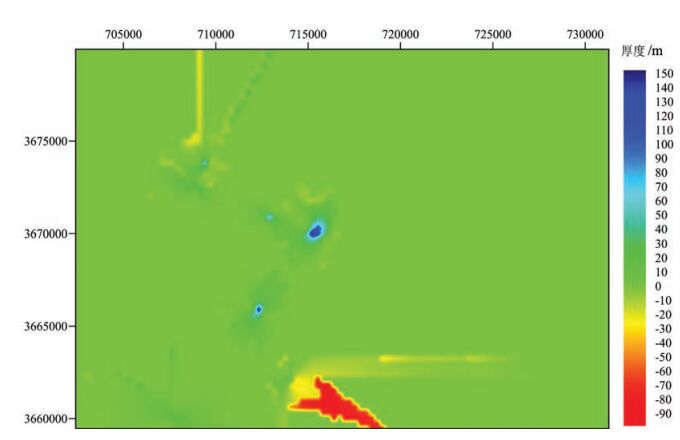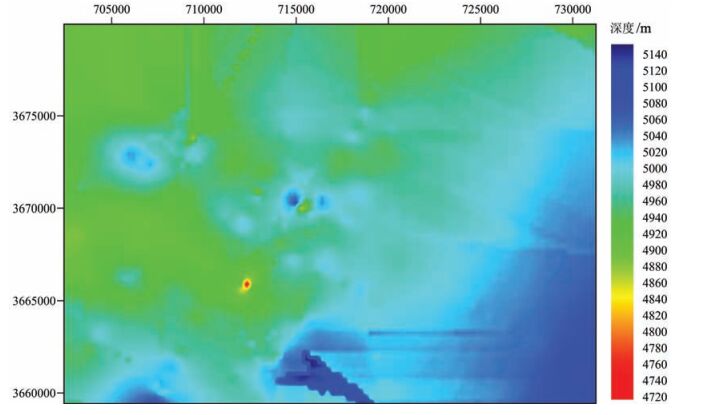An analysis of gas hydrate accumulation condition in the Duck Lake area, Qiangtang Basin, northern Tibet
-
摘要:
近年来中国陆域冻土区天然气水合物调查研究结果表明,气源条件是制约羌塘盆地天然气水合物找矿突破的关键因素。为明确鸭湖地区天然气水合物成藏潜力,基于近年来的钻探调查成果,从陆域冻土区天然气水合物成藏系统理论出发,系统分析了影响天然气水合物成藏的冻土、气源、储集、构造等地质因素。分析结果显示,鸭湖地区局部具有较好的冻土、地温、气源、储集、构造及水源条件,具备一定的天然气水合物成藏潜力,继续寻找充足的烃类气源是下一步天然气水合物调查的主要方向。同时,选取钻探调查获取的地温梯度、气体组分等参数,结合音频大地电磁测深(AMT)冻土厚度调查成果,对鸭湖地区天然气水合物稳定带的厚度和底界深度进行了预测。结果显示,当甲烷为85%、乙烷为9%、丙烷为6%时,天然气水合物稳定带厚度与冻土厚度分布变化基本一致,稳定带厚度400~630m,底界深度400~680m。当甲烷为98%、乙烷为2%时,天然气水合物稳定带厚度急剧减薄,大部分地区仅有0~30m,最厚仅有150m,局部地区稳定带底界最深仅为240m。结合气测录井结果,认为渐新世唢呐湖组比上三叠统土门格拉组更具备天然气水合物成藏潜力,土门格拉组自身具备较强的生排烃能力,可作为寻找常规油气或页岩气的一个重要层位。
Abstract:In recent years, the gas hydrate investigation in the permafrost region of China shows that the gas source condition is the key factor for controlling the breakthrough of gas hydrate exploration in the Qiangtang Basin. In order to further clarify the potential of gas hydrate accumulation in the Duck Lake area, the authors systematically analyzed such geological factors as permafrost, gas source, reservoir and structure based on the drilling results in recent years. The results show that there are good conditions of permafrost, geothermal gradient, gas source, reservoir, structure and water source in some areas, indicating that Duck Lake area has a certain gas hydrate accumulation potential. Finding sufficient hydrocarbon gas sources will be the main direction of the next gas hydrate investigation. In addition, the thickness of the gas hydrate stability zone (GHSZ) and the depth of bottom of GHSZ in the Duck Lake area were predicted by the data of the geothermal gradient and the gas composition obtained from the drilling and AMT results. Predictive results show that, when the methane is 85%, ethane is 9% and propane is 6%, the thickness distribution of GHSZ is basically the same as that of the permafrost. The thickness of GHSZ is between 400m and 630m, and the depth of the bottom of GHSZ is between 400m and 680m. Where methane is 98% and ethane is 2%, the thickness of GHSZ is sharply thinned, only 0~30m in most areas and only 150m thick in certain areas, and the depth of the deepest bottom of GHSZ is only 240m. Based on the results of gas logging, it is concluded that the Oligocene Suonahu Formation has more potential gas hydrate accumulation potential than the Upper Triassic Tumengela Formation in Duck Lake area, while Tumengela Formation has strong hydrocarbon generation and expulsion capability, which thus can be regarded as an important horizon for exploration of conventional oil and gas or shale gas.
-
Keywords:
- gas hydrate /
- accumulation condition /
- Duck Lake area /
- Qiangtang Basin
-
随着地球科学家对地球系统研究的不断深入,人们发现新元古代时地球系统发生了一系列的剧烈变化。在地球地质历史的这一时期,地球从较稳定的古-中元古代(17~7.5亿年)[1],进入剧烈变动的中-晚新元古代时期(7.5~5.4亿年)。中-晚新元古代地球上出现多期极冷事件[2-7],条带状铁矿也在消失十多亿年后,在新元古代中期又重新出现[1, 8],大洋与大气圈的氧含量快速增加[9-11]。地球系统这一系列的剧变很可能发生在Rodinia超大陆裂解的背景下。因此,重建这一时期的古地理古板块位置对于理解这些剧变至关重要。然而,由于这一时期(7.5~5.4亿年)全球不同块体古地磁数据的缺乏和可靠性问题,其古地理重建一直存在较大的争议[12-20]。
影响这一时期古地磁数据可靠性的因素,除了考虑剩磁的获得时间外,近年来越来越多的学者注意到非偶极子场及磁倾角偏低对古地磁数据的影响[21-26],特别是红层中存在普遍的磁倾角偏低现象[27-28]。
最近,Jing等[29]报道了湖北宜昌三峡地区莲沱组红层可靠的古地磁极,并根据Lan等[30]最新的SIMS锆石U-Pb定年研究,确定这一古地磁极年龄应为720Ma。虽然这一古地磁极通过了Van der Voo[31]的6项Q检验,确保其剩磁获得的原生性,但这一结果是否受到后期压实作用的影响并产生磁倾角偏低,以及影响程度的大小等问题,都需要进一步研究。在长阳地区,由于古城冰碛岩覆盖在莲沱组之上,因此准确确定莲沱组的磁倾角,对确定华南这一时期的古纬度及“雪球地球”的研究都具有重要意义。另外,目前华南地块莲沱组古地磁极与南沱组古地磁极相似的问题,一直没有得到可信的解释,本文通过磁倾角偏低的研究,对这一问题进行探讨。
1. 区域地质概况及采样
采样区位于华南新元古代地层典型剖面区,湖北三峡地区(图 1)。研究区出露的新元古代沉积地层包括莲沱组、南沱组、陡山沱组、灯影组等。莲沱组一般不整合覆盖于黄陵花岗岩之上,主要为厚层的紫红色砂岩和砾岩,可分为2个大的沉积旋回(图 2),每个旋回底部为砾石或粗粒石英砂岩,向上逐渐变为粉砂岩、泥质砂岩,含多层凝灰岩或凝灰质碎屑岩。在区域上,西北部地层厚度较大,向西南变薄。本区南沱组与莲沱组平行不整合接触或低角度不整合接触,南沱组主要为暗绿色冰碛砾岩,部分为红色冰碛岩[32]。
![]() 图 2 本次研究获取的采点(下划线标注TLS编号)在地层上的分布(TL编号为Jing等[29]采点)Figure 2. Stratigraphic column of the Liantuo Formation and detailed sampling layer positions of three sub-sections at Yichang
图 2 本次研究获取的采点(下划线标注TLS编号)在地层上的分布(TL编号为Jing等[29]采点)Figure 2. Stratigraphic column of the Liantuo Formation and detailed sampling layer positions of three sub-sections at Yichang在三峡地区南部的长阳地区,莲沱组之上覆盖古城组冰碛岩和大塘坡组页岩,而不是直接与南沱组接触[33]。古城组冰碛岩应与扬子西南部广泛发育的长安组冰碛岩一致[33],属于Sturtian冰期的产物。古城组沉积时间应始于715Ma左右[33]。
三峡地区从埃迪卡拉纪开始长期沉积碳酸盐岩,早寒武世有一次沉积间断,直到志留纪宜昌地区大规模抬升,沉积间断接受剥蚀,随后沉陷到早三叠世再次抬升[34-35]。本地区经历了3次主要的构造运动:加里东期、印支期和燕山期构造运动。同时中扬子地区存在与这3次构造运动相关的3期油气生成和排烃过程[36]。区域内构造变形较弱。
本次在宜昌花鸡坡、头顶石及田家院子3个剖面共采集了17块手标本样品(TLS1-17),对莲沱组是否存在磁倾角偏低现象进行检验(图 2)。样品在野外用罗盘测量层面的走向和倾角,并标记在层面上。
2. 实验方法
在室内用台式钻机垂直手标本层面钻取2根以上岩心,并加工出1~2块高2.2cm、直径2.5cm的标准岩心样品。每根岩心选取1~2块,共31块标准样品进行系统热退磁实验。同时对应选择了30块样品进行Hodych等[23]磁倾角偏低校正实验。所有实验工作均在中国地质科学院地质力学研究所国土资源部古地磁与古构造重建重点实验室完成。使用美国ASC Scientific Inc.公司生产的IM-10-30脉冲充磁仪对样品进行充磁,样品系统热退磁由TD-48大型热退磁仪完成,样品剩磁测量在ARGICO-JR6A旋转磁力仪上完成。另外,对部分样品利用KLY-3 Kappabridges进行了氮气环境下磁化率随温度变化实验(K-T),获取连续加热-冷却曲线分析样品磁化率的变化。
3. 实验结果
3.1 逐步热退磁结果
宜昌三峡地区花鸡坡、头顶石及田家院子剖面莲沱组样品的岩石磁学实验结果显示,岩石的特征剩磁载磁矿物为赤铁矿[29]。因此,系统热退磁温度区间在低温段以50~100℃为间隔,高温段温度区间以20℃为间隔,热退磁温度达到680℃(图 3)。样品使用主向量分析法[37]进行剩磁组分分析。
逐步热退磁结果显示,样品中共可以分离出3个剩磁方向(图 3):低温分量一般在小于等于300℃的情况下分离出来, 共有15块样品分离出此分量,其在地理坐标系下的统计方向(Dg=5.9°,Ig=60.1°,kg=81.3, ɑ95=4.3°)与采样点现代地磁场方向接近,应为现代地磁场的热粘滞剩磁;中温分量的温度区间一般在300~600~640℃之间,共有6块样品分离出此分量,其平均方向在地理坐标系下为Dg=34.5°,Ig=78.1°,kg=244.2,ɑ95=4.3°,在地层坐标系下为Ds=78.9°,Is=78.4°,ks=243.5,ɑ95=4.3°。另外,从11块样品中分离出了与宜昌剖面得到的特征分量相似的高温分量(600~680℃),其平均方向在地理坐标系下为Dg=67.0°,Ig=71.6°,kg=124.7,ɑ95=3.9°,在地层坐标系下为Ds=95.3°,Is=67.8°,ks=196.0,ɑ95=3.1°。
3.2 等温剩磁各向异性实验结果
对12个样品,在与其层面呈45°方向,从低到高逐步增加等温直流磁场,获得平行于层面IRMx和垂直于层面IRMz的等温剩磁,直流磁场大小由20、40、60、100、225、315、415、510、510、710、810、950、1200mT依次递增。在每步施加直流场后使用JR6旋转磁力仪对样品进行剩磁测试。然后用TD48大型热退磁炉对所有样品进行系统热退磁,相关数据结果列于表 1中。
表 1 宜昌地区剖面莲沱组样品等温热剩磁各向异性及磁倾角偏低值Table 1. Anisotropy of isothermal remnant magnetization for Liantuo Formation red beds in Yichang areaID Iobs IRMz/IRMx
(610~1200mT)IF1 ΔI1(=IF1-Iobs) IRMz/IRMx
(600°C以上)IF2 ΔI2(=IF2-Iobs) 15 64.4 0.7796 69.518 5.118 0.8542 67.7425 3.3425 15-2c 71.5 0.8414 74.277 2.777 0.8513 74.1009 2.6009 15-5b 65 0.899 67.256 2.256 0.8757 67.7876 2.7876 17-1 72.1 0.831 74.976 2.876 0.8118 75.3075 3.2075 3-1 73 0.87 75.105 2.105 0.8859 74.8452 1.8452 4-2b 66.3 0.6147 74.899 8.599 0.901 68.4206 2.1206 5-2b 64.2 0.8472 67.728 3.528 0.9117 66.2153 2.0153 5-4b 66 0.7989 70.420 4.420 0.872 68.7818 2.7818 7-1 61.9 0.8579 65.389 3.489 0.8731 65.0054 3.1054 8-3 70 0.8737 72.359 2.359 0.856 72.6951 2.6951 8-4 66.8 0.8701 69.548 2.748 0.8977 68.9555 2.1555 平均值 67.8 0.8258 71.377 3.577 0.8719 70.4146 2.6146 注:ID为样品号,Iobs为热退磁实验所得样品磁倾角,IRMz/IRMx(610~1200mT)为610~1200mT之间垂直层面方向和平行层面方向等温剩磁大小的比值,IRMz/IRMx(600°C以上)为600 °C以上垂直层面方向和平行层面方向等温剩磁大小的比值,IF为校正后磁倾角,ΔI为校正值 考虑到实验过程中样品的等温剩磁方向可能受天然剩磁的影响,以及载磁矿物主要为赤铁矿,所以施加外部直流场在200~1200mT之间及系统热退磁温度在600~680℃之间的IRMz/IRMx拟合线反映了赤铁矿的剩磁各向异性特征。
由于垂直于层面的IRMz值大部分在500mT之后略小于平行于层面的IRMx值(图 4-a、d),所以从磁场强度方面考虑,选取在500mT之后的610~1200mT区间的IRMz/IRMx拟合线的斜率作为磁倾角偏低校正因子,其大小为0.8258,对应的沉积压实为18%。另外,从热退磁的方面考虑,选取600~680℃区间的IRMz/IRMx热退磁结果拟合线的斜率作为磁倾角偏低校正因子,其大小为0.8719,对应的沉积压实为13%。利用公式IRMz/ IRMx=tan (Iobs)/tan (IF)进行校正后得到莲沱组磁倾角分别为71.4°和70.4°,两者的磁倾角值差别不大。
![]() 图 4 45°方向加场后平行于层面方向(IRMx)和垂直于层面方向(IRMz)等温剩磁获得曲线图(a, d),IRMz/IRMx关系图(b, e)和IRMz/IRMx的热退磁结果(c, f)Figure 4. Plots of IRMx (parallel to bedding) and IRMz (perpendicular to bedding) acquisitions produced by applying magnetic field at 45° to bedding as function of increasing field (a, d), plots of IRMZ/IRMX(b, e), the thermal demagnetization results of IRMZ/IRMX(c, f)
图 4 45°方向加场后平行于层面方向(IRMx)和垂直于层面方向(IRMz)等温剩磁获得曲线图(a, d),IRMz/IRMx关系图(b, e)和IRMz/IRMx的热退磁结果(c, f)Figure 4. Plots of IRMx (parallel to bedding) and IRMz (perpendicular to bedding) acquisitions produced by applying magnetic field at 45° to bedding as function of increasing field (a, d), plots of IRMZ/IRMX(b, e), the thermal demagnetization results of IRMZ/IRMX(c, f)3.3 岩石磁学实验结果
为了排除样品在加热过程中可能存在的磁性矿物的变化,对几个代表性样品进行了磁化率随温度变化实验(K-T,图 5)。结果表明,部分样品在加热和冷却过程中样品磁化率明显不同(图 5,TLS11),可能是因为样品在加热过程中生成了一部分磁铁矿。但580~680℃之间的加热曲线与冷却曲线一致,表明加热过程中磁性矿物的变化并未影响到样品中赤铁矿的剩磁变化(图 5,TLS11),因此,不影响磁倾角偏低实验的结果。另一部分样品的K-T曲线显示,在加热与冷却过程中,样品的磁化率没有明显的差异,因此样品中不存在明显的磁性矿物的改变(图 5,TLS4)。
由于加热过程并未影响到高温分量载磁性矿物赤铁矿,再考虑到赤铁矿较大的矫顽力,因此,选用600~680℃区间的IRMz/IRMx值作为磁倾角偏低校正因子,利用公式IRMz/IRMx=tan (Iobs)/tan(IF)计算得到校正后的莲沱组磁倾角大小为70.4°,与热退磁实验所得莲沱组磁倾角67.8°比较,莲沱组的磁倾角偏低大小为2.6°。
4. 磁倾角偏低对莲沱组古纬度及古地磁极的影响
利用本研究得到的莲沱组磁倾角偏低校正因子,对Jing等[29]所得高温分量进行磁倾角偏低校正,利用校正后的高温分量求得的三峡地区莲沱组沉积古纬度为47.7°±5.1°,比校正前的43.7°±4.8°向高纬度地区运动了3.9°±6°。
校正后古地磁极(LT-corr)为14.7°N, 153.9°E, dp/dm=4.9/6.0,与未校正的莲沱组古地磁极(LT:12.7°N,157.4°E,dp/dm=4.5/5.8)相比更偏西北。虽然校正前后,莲沱组古地磁极在统计分析上不能显著区分,但校正后的莲沱组古地磁极与现有华南南沱组古地磁极(Nantuo)[38]明显不同(图 6)。
5. 讨论
由于Evans等[39]得到的莲沱组古地磁极与南沱组古地磁极重合,使得一些学者认为莲沱组古地磁结果可能比以前认为的更年轻[40],或是南沱期重磁化的结果。然而,Jing等[29]对宜昌莲沱组的古地磁研究表明,莲沱组中下部到顶部至少存在5个正负极性时,因此现有的莲沱组古地磁结果应该不是重磁化的结果。另外,Jing等[29]通过总结前人在三峡地区对莲沱组大量的定年结果[41-45],认为现有华南莲沱组古地磁极年龄应在720Ma左右,比之前认为的750Ma年轻,但仍老于635Ma的南沱组古地磁结果。
Jing等[29]得到的莲沱组古地磁极与南沱组古地磁极相差不大。Yang等[46]认为,莲沱组采样区可能发生过局部构造旋转作用;Zhang等[38]则认为,没有证据表明莲沱组采样区发生过局部旋转。
排除以上各方面的影响因素,笔者认为,造成莲沱组与南沱组古地磁极相似的原因应该与莲沱组岩石受压实作用影响、发生微弱的磁倾角偏低现象有关。由于目前未对南沱组取得高温分量的古地磁样品进行磁倾角偏低实验,两者真实的差别还不能确定,需要进一步研究。
经磁倾角偏低校正后的华南板块在720Ma时应位于中纬度地区(图 6)。这一时期扬子地块多处发育冰碛岩沉积,从该时期华南板块上发育的冰碛岩分布看[40],当时整个地球应处于较寒冷的气候阶段。但由于这一时期华南板块位于中纬度地区,对于地球这一时期是否处于“雪球地球”的环境,仅从莲沱组的古地磁结果不能做出明确的判定。
为此,笔者重建了华南板块及与华南关系较紧密的澳大利亚-东南极板块720Ma的古地理位置(图 6)。图 6中,将莲沱组古地磁极通过欧拉极(34.4°N、100°E,98.6°)旋转到地理北极。MDS、YF及EF分别为澳大利亚755Ma,640Ma和635Ma古地磁极[22, 47-48],位于同一大圆弧上(虚线),利用内插法求出其720Ma的古地磁极位置,通过欧拉极(-0.4°N、53.7°E,44.1°)旋转使其与莲沱组古地磁极重合。通过这一古地理重建,可以清楚地看到,这一时期有大量冰川从中纬度地区一直延续到赤道地区。这一证据直接证明,当时地球处于“雪球地球”的环境。
6. 结论
对华南三峡地区莲沱组的等温剩磁各向异性研究表明,通过磁倾角偏低校正后的莲沱组古地磁极与南沱组古地磁极存在明显差别,这表明造成莲沱组与南沱组古地磁极相似的一个重要原因是地层压实引起的磁倾角偏低。利用720Ma古地磁数据对华南和澳大利亚进行古地理重建,并对比这一时期冰碛岩的分布,结果表明,当时地球确实处于“雪球地球”的环境中。
致谢: 野外工作期间得到西藏地勘局地热地质大队顿珠经理、米玛经理、普次主任、屈志强机长、何兴国副机长,中石化胜利石油工程有限公司地质录井公司王昊经理,贵仁科技有限公司方纬总监,西藏金轩汽车租赁咨询公司金开活经理等同志的大力帮助,在此一并表示衷心的感谢。 -
图 1 羌塘盆地构造单元划分[24]及鸭湖地区位置
Figure 1. Division of tectonic units in the Qiangtang Basin and location of the Duck Lake area
图 2 鸭湖地区地质图 ① 及天然气水合物地质调查井位置
Figure 2. Geological map of Duck Lake area and location of gas hydrate investigation wells
表 1 鸭湖地区天然气水合物调查井钻探概况
Table 1 Overview of gas hydrate investigation wells in Duck Lake area
钻井
编号海拔/m 井深/m 冻土层
厚度/m冻土层以内地温
梯度(/ ℃· 100m-1)冻土层以下地温
梯度(/ ℃· 100m-1)钻遇地层 主要岩性 异常特征 QK-2 4970 389.85 38 未测得 2.15 Q,T3t 第四系沉积物、细-中砂岩、泥
岩、泥质粉砂岩、粉砂质泥岩H2S气体,自生黄
铁矿和方解石QK-6 4960 246.4 未测井 未测井 未测井 Q 第四系沉积物 烃类气体异常 QK-7 4960 684 120 1.24 3.66 Q,E2s,T3t 第四系沉积物、泥灰岩、泥岩、
泥质粉砂岩、粉砂质泥岩丰富烃类气体 注:地层代号同图 2 表 2 鸭湖地区天然气水合物潜在储集岩类型
Table 2 Types of gas hydrate potential reservoir rocks in Duck Lake area
地层 岩石类型 成岩作用 主要储集类型 储集性 第四系(Q) 松散沉积物 差 孔隙型 好 渐新世唢呐湖组(E2s) 泥岩、泥灰岩、粗砂岩、中砂岩、细砂岩、粉砂岩 较差 孔隙型为主,裂隙型次之 较好 上三叠统土门格拉组(T3t) 粗砂岩、中砂岩、细砂岩、粉砂岩、泥质粉砂岩、泥岩 强 裂隙型为主,孔隙型次之 一般 -
Kvenvolden K A. A primer in gas hydrate[C]//Howell D G. The fu-ture of energy gases. U. S. Geological Survey, 1993, 1570:279-292.
Sloan E D. Clathrate Hydrate of Natural Gases (Second edit)[M]. New York:Marcel Dekker Inc., 1998:1-628.
Collett T S. Permafrost-associated gas hydrate[C]//Max M D. Natu-ral gas hydrate in oceanic and permafrost environments. The Nether-lands, Kluwer Academic Publishers, 2000:43-60.
Kvenvolden K A, Lorenson T D. The global occurrence of natural gas hydrate[J]. American Geophysical Union, 2001, 124:3-18. https://www.onepetro.org/download/conference-paper/ISOPE-I-01-069?id=conference-paper%2FISOPE-I-01-069
祝有海, 张永勤, 文怀军, 等.青海祁连山冻土区发现天然气水合物[J].地质学报, 2009, 83(11):1761-1770. http://www.cnki.com.cn/Article/CJFDTOTAL-DZXE200911020.htm Dallimore S R, Collett T S. Summary and implication of the Mallik 2002 gas hydrate production research well program[C]//Dallimore S R, Collett T S. Scientific Results from the Mallik 2002 Gas Hydrate Production Research Well Program, Mackenzie Delta, Northwest Territories, Canada. Geological Survey of Canada, 2005, 585:1-36.
Makogon Y F, Holditch S A, Makogon T Y. Natural gas-hydrates-A potential energy source for the 21st Century[J]. Journal of Petro-leum Science and Engineering, 2007, 56:14-31. doi: 10.1016/j.petrol.2005.10.009
祝有海, 卢振权, 谢锡林.青藏高原天然气水合物潜在分布区预测[J].地质通报, 2011, 30(12):1918-1926. doi: 10.3969/j.issn.1671-2552.2011.12.016 祝有海, 赵省民, 卢振权.中国冻土区天然气水合物的找矿选区及其资源潜力[J].天然气工业, 2011, 31(1):13-19. http://www.cnki.com.cn/Article/CJFDTOTAL-TRQG201101004.htm 徐学祖, 程国栋, 俞祁浩.青藏高原多年冻土区天然气水合物的研究前景和建议[J].地球科学进展. 1999, 14(2):201-204. http://www.cnki.com.cn/Article/CJFDTOTAL-DXJZ902.017.htm 张立新, 徐学祖, 马巍.青藏高原多年冻土区与天然气水合物[J].天然气地球科学, 2001, 12(1/2):22-26. http://www.cnki.com.cn/Article/CJFDTOTAL-TRYS201102015.htm 黄朋, 潘桂棠, 王立全, 等.青藏高原天然气水合物资源预测[J].地质通报, 2002, 21(11):794-798. doi: 10.3969/j.issn.1671-2552.2002.11.019 伊海生, 时志强, 刘文军.青藏高原多年冻土区天然气水合物形成潜力及远景[J].西藏地质, 2002, 20(1):46-49. http://www.cnki.com.cn/Article/CJFDTOTAL-DQWX200901020.htm 刘怀山, 韩晓丽.西藏羌塘盆地天然气水合物地球物理特征识别与预测[J].西北地质, 2004, 37(4):33-38. http://www.cnki.com.cn/Article/CJFDTOTAL-XBDI200404006.htm 陈多福, 王茂春, 夏斌.青藏高原冻土带天然气水合物的形成条件与分布预测[J].地球物理学报, 2005, 48(1):165-172. http://www.cnki.com.cn/Article/CJFDTOTAL-DQWX200501022.htm 吴青柏, 蒋观利, 蒲毅彬, 等.青藏高原天然气水合物的形成与多年冻土的关系[J].地质通报, 2006, 25(1/2):29-33. http://dzhtb.cgs.cn/ch/reader/view_abstract.aspx?flag=1&file_no=20060106&journal_id=gbc 库新勃, 吴青柏, 蒋观利.青藏高原多年冻土区天然气水合物可能分布范围研究[J].天然气地球科学, 2007, 18(4):588-592. http://www.cnki.com.cn/Article/CJFDTOTAL-TDKX200704024.htm 郭祖军, 陈志勇, 胡素云, 等.天然气水合物分布及青藏高原有利勘探区[J].新疆石油地质, 2012, 33(3):266-271. http://www.cnki.com.cn/Article/CJFDTOTAL-XJSD201203001.htm He J, Wang J, Fu X, et al. Assessing in the conditions favorable for the occurrence of gas hydrate in the Tuonamu area Qiangtang Ba-sin, Qinghai-Tibetan, China[J]. Energy Conversion and Manage-ment, 2012, 53:11-18. doi: 10.1016/j.enconman.2011.08.012
Fu X, Wang J, Tan F, et al. Gas hydrate formation and accumula-tion potential in the Qiangtang Basin, northern Tibet, China[J]. En-ergy Conversion and Management, 2013, 73:186-194. doi: 10.1016/j.enconman.2013.04.020
刘增乾, 徐宪, 潘桂棠.青藏高原大地构造与形成演化[M].北京:地质出版社, 1990:9-34. 余光明, 王成善.西藏特提斯沉积地质[M].北京:地质出版社, 1990:94-98. 赵政璋, 李永铁, 叶和飞, 等.青藏高原羌塘盆地石油地质[M].北京:科学出版社, 2001:1-367. 王剑, 丁俊, 王成善, 等.青藏高原油气资源战略选区调查与评价[M].北京:地质出版社, 2009. 赵政璋, 李永铁, 叶和飞, 等.青藏高原大地构造特征及盆地演化[M].北京:科学出版社, 2000. 王成善, 伊海生, 李勇, 等.西藏羌塘盆地地质演化与油气远景评价[M].北京:地质出版社, 2001:224-225. 王成善, 伊海生, 刘池洋, 等.西藏羌塘盆地古油藏发现及其意义[J].石油与天然气地质, 2004, 25(2):139-143. doi: 10.11743/ogg20040204 Xu W, Ruppel C. Predicting the occurrence, distribution, and evo-lution of methane gas hydrate in porous marine sediments[J]. Jour-nal of Geophysical Research, 1999, 104(B3):5081-5095. doi: 10.1029/1998JB900092
Bunz S, Mienert J, Bemdt C. Geological controls on the storage gas-hydrate system of the mid-Norweigian continental margian[J]. Earth and Planetary Science Letters, 2003, 209:291-307. doi: 10.1016/S0012-821X(03)00097-9
Milkov A V, Clapool G, Lee Y J, et al. Gas hydrate systems at Hy-drate Ridge offshore Oregon inferred from molecular and isotopic properties of hydrate-bound and void gases[J]. Geochimica et Cos-mochimica Acta, 2005, 69(4):1007-1026. doi: 10.1016/j.gca.2004.08.021
吴能友, 张海啟, 杨胜雄, 等.南海神狐海域天然气水合物成藏系统初探[J].天然气工业, 2007, 27(9):1-6. http://www.cnki.com.cn/Article/CJFDTOTAL-TRQG200709004.htm 吴能友, 梁金强, 王宏斌, 等.海洋天然气水合物成藏系统研究进展.现代地质, 2008, 22(3):356-362. http://www.cnki.com.cn/Article/CJFDTOTAL-XDDZ200803003.htm 卢振权, 吴能友, 陈建文, 等.试论天然气水合物成藏系统.现代地质, 2008, 22(3):363-375. http://www.cnki.com.cn/Article/CJFDTOTAL-XDDZ200803004.htm Collett T S, Johnson A, Knapp C, et al. Natural Gas Hydrate-A Review[C]//Collett T S, Johnson A, Knapp C, et al. Natural Gas Hydrates-Energy Resource Potential and Associated Geologic Haz-ards. AAPG Memoir, 2009, 89:153-162.
王平康, 祝有海, 卢振权, 等. 浅析祁连山冻土区天然气水合物成藏体系[C]//海峡两岸天然气水合物学术交流会论文集, 2010: 52. 卢振权, 祝有海, 张永勤, 等. 祁连山冻土区天然气水合物成藏系统[C]//中国地质学会2013年学术年会, 2013: 459-461. 翟刚毅, 卢振权, 卢海龙, 等.祁连山冻土区天然气水合物成矿系统[J].矿物岩石, 2014, 34(4):79-92. http://cpfd.cnki.com.cn/Article/CPFDTOTAL-ZGDJ201310012067.htm 王平康, 祝有海, 张旭辉, 等.羌塘盆地冻土结构特征及其对天然气水合物成藏的影响[J].沉积与特提斯地质, 2015, 35(1):57-67. http://www.cnki.com.cn/Article/CJFDTOTAL-TTSD201501008.htm 戴金星.各类天然气的成因鉴别[J].中国海上油气:地质, 1992, 1:11-19. http://www.cnki.com.cn/Article/CJFDTOTAL-ZHSD199201005.htm 肖睿. 西藏羌塘盆地天然气水合物气源研究[D]. 中国地质科学院硕士学位论文, 2015. 杨润田, 林凤桐.多年冻土区水文地质及工程地质学[M].哈尔滨:东北林业大学出版社, 1986:134. 陈俊, 王鹤年.地球化学[M].北京:科学出版社, 2004:116. 成都地质矿产研究所.《吐错幅》(I45C003004)(比例尺1:250000)地质调查报告. 2010.




 下载:
下载:





